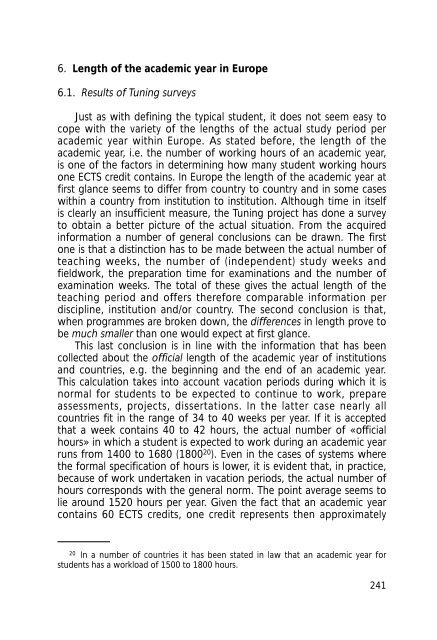Final Report Pilot Project - Relaciones Internacionales de la ...
Final Report Pilot Project - Relaciones Internacionales de la ...
Final Report Pilot Project - Relaciones Internacionales de la ...
Create successful ePaper yourself
Turn your PDF publications into a flip-book with our unique Google optimized e-Paper software.
6. Length of the aca<strong>de</strong>mic year in Europe<br />
6.1. Results of Tuning surveys<br />
Just as with <strong>de</strong>fining the typical stu<strong>de</strong>nt, it does not seem easy to<br />
cope with the variety of the lengths of the actual study period per<br />
aca<strong>de</strong>mic year within Europe. As stated before, the length of the<br />
aca<strong>de</strong>mic year, i.e. the number of working hours of an aca<strong>de</strong>mic year,<br />
is one of the factors in <strong>de</strong>termining how many stu<strong>de</strong>nt working hours<br />
one ECTS credit contains. In Europe the length of the aca<strong>de</strong>mic year at<br />
first g<strong>la</strong>nce seems to differ from country to country and in some cases<br />
within a country from institution to institution. Although time in itself<br />
is clearly an insufficient measure, the Tuning project has done a survey<br />
to obtain a better picture of the actual situation. From the acquired<br />
information a number of general conclusions can be drawn. The first<br />
one is that a distinction has to be ma<strong>de</strong> between the actual number of<br />
teaching weeks, the number of (in<strong>de</strong>pen<strong>de</strong>nt) study weeks and<br />
fieldwork, the preparation time for examinations and the number of<br />
examination weeks. The total of these gives the actual length of the<br />
teaching period and offers therefore comparable information per<br />
discipline, institution and/or country. The second conclusion is that,<br />
when programmes are broken down, the differences in length prove to<br />
be much smaller than one would expect at first g<strong>la</strong>nce.<br />
This <strong>la</strong>st conclusion is in line with the information that has been<br />
collected about the official length of the aca<strong>de</strong>mic year of institutions<br />
and countries, e.g. the beginning and the end of an aca<strong>de</strong>mic year.<br />
This calcu<strong>la</strong>tion takes into account vacation periods during which it is<br />
normal for stu<strong>de</strong>nts to be expected to continue to work, prepare<br />
assessments, projects, dissertations. In the <strong>la</strong>tter case nearly all<br />
countries fit in the range of 34 to 40 weeks per year. If it is accepted<br />
that a week contains 40 to 42 hours, the actual number of «official<br />
hours» in which a stu<strong>de</strong>nt is expected to work during an aca<strong>de</strong>mic year<br />
runs from 1400 to 1680 (1800 20 ). Even in the cases of systems where<br />
the formal specification of hours is lower, it is evi<strong>de</strong>nt that, in practice,<br />
because of work un<strong>de</strong>rtaken in vacation periods, the actual number of<br />
hours corresponds with the general norm. The point average seems to<br />
lie around 1520 hours per year. Given the fact that an aca<strong>de</strong>mic year<br />
contains 60 ECTS credits, one credit represents then approximately<br />
20 In a number of countries it has been stated in <strong>la</strong>w that an aca<strong>de</strong>mic year for<br />
stu<strong>de</strong>nts has a workload of 1500 to 1800 hours.<br />
241


